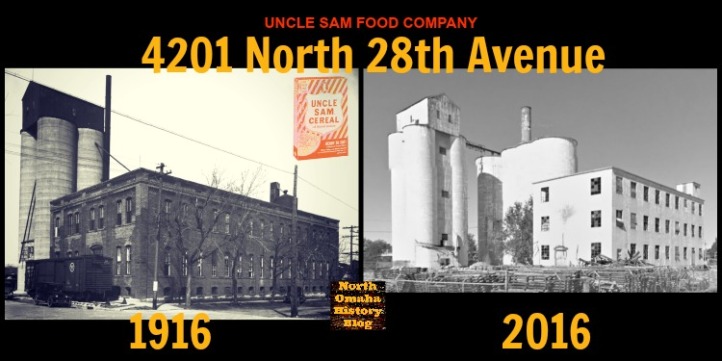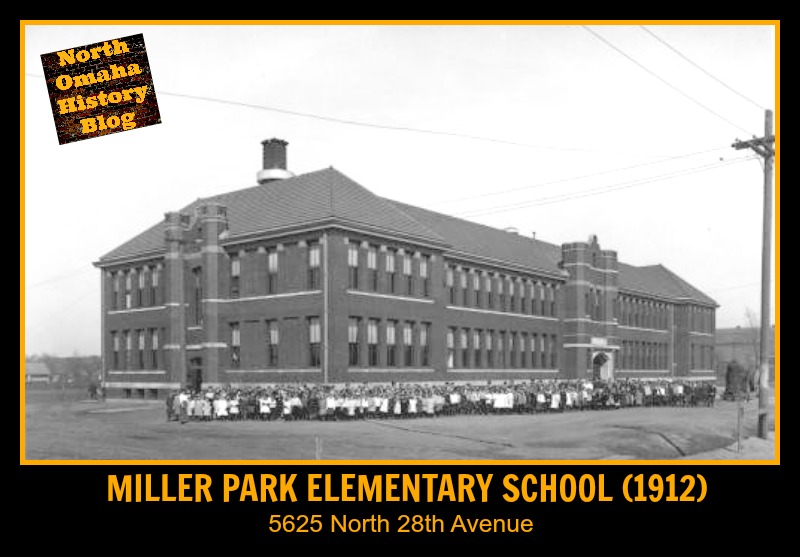“No more constipation or stomach trouble if you eat Uncle Sam anti-dyseptic breakfast food,” screams a 1908 ad from the Omaha World-Herald. From the outset of the company, its pretense was plain: Eat our cereal and you’ll poop better. Since then, generations of Americans have done just that, and even though it’s not made in Omaha anymore, the cereal is still at work fighting constipation. This is a history of the company that sold Uncle Sam Cereal and more to the world.

In spring 1908, Lafayette Coltrin (1840-1917) established the Uncle Sam Breakfast Food Company at 4201 North 28th Avenue in North Omaha. Located along the almost-entirely industrial Belt Line railway, the surrounding neighborhood was almost entirely industrial, including a rubber factory, a truck-making plant, casket manufacturers, and more. Buying a large warehouse already on the block, Coltrin had another one built.
Soon after, Coltrin sold his company to an investment group that believed the healthy food would become massively popular, and this plant was thought to be an initial investment in their successful business. The label eventually claimed it was, “a natural laxative… a regularity favorite.” Led by a man named James W. McGowan, the company survived for more than 80 years, and the brand is still made today.

Arriving to the plant through railcars, wheat and flax seed were sorted into huge bins in the basement of the factory. Then, new kinds of machinery for the times boiled, heated and pressed the plants into flakes, mixing celery salt in along the way. The box eventually proclaimed it “a natural whole grain cereal no added sugar, no preservatives, no artificial colorings.” It was packaged in a special paper different from other cereals because of the high oil content in flaxseed.
Claiming to have medicinal properties, Uncle Sam Breakfast Food claimed to cure almost every ailment facing stomachs, including ulcers, constipation, bowel problems and more. In 1910, the United States Department of Agriculture Bureau of Chemistry took Uncle Sam to court on account of misinforming customers about the cereal’s health values. They were fined $10 and insisted they couldn’t make medicinal claims afterward. After then, Uncle Sam focused on simply relieving constipation instead of the array of health issues they wanted to address. That said, the company advertised extensively through medical journals and health magazines throughout the 1910s and 20s, with criticism written about the company’s claims a regular feature, too!
Building the Business

In its first year, the company claimed to manufacture 14,000 cartons of cereal every day, with increases planned. In 1910, the company expanded and bought an additional lot on their block to expand their factory. Everyone in North Omaha knew the distinct smell of Uncle Sam cereal because of the plant’s aroma.
In 1912, there was a tour of the then-industrial Belt Line Railway for businessmen throughout Omaha. Making a grand stop at the factory, more than 100 economic tourists were treated to bowls of Uncle Sam and given gift bags filled with swag from around the city. According to the newspaper, many noted the surprising size of the factory, and it’s industriousness. A year later, in May 1913, the plant was doubled in size. In 1914, the company built a cement elevator that has stood since.

During World War I, the company joined the pro-war effort by creating a barley cereal. This allowed more wheat to be used for troops overseas, and allowed for slowed wheat production on farms across the nation while young workers went overseas. The company’s “Liberty Barley Flakes” appear to have only been sold for a few years though.
In 1917, the company’s founder Lafayette Coltrin passed away in Long Beach, California. Originally from Ohio, Coltrin chose Omaha for its proximity to flax producers, central location on the nation’s railroads, and its under-utilized proximity to the “cereal belt,” where a lot of the nation’s breakfast foods were produced. Several years after his death, there was an ugly court battle between the company and Coltrin’s widow over the royalties owed to the cereal’s inventor.
Luckily, the company built up around Coltrin, his image and his cereal was made to last.

The company started manufacturing Skinner’s Raisin Bran, the first of its kind in the United States, in 1926 for the Skinner Macaroni Company of Omaha.
During World War II, Uncle Sam Breakfast Food Company again contributed to the war effort, freely distributing a booklet called The ABCs of Wartime Canning. The booklet was filled with recipes and substitutions.
In 1950, Uncle Sam continued its healthful claims, with an ad proudly reporting,
“For many years, doctors have recognized that flaxseed tends to stimulate peristaltic action of the intestines (bowel action). You see, flaxseed helps serve as a LUBRICANT. Many persons enjoy a daily serving of Uncle Sam Laxative Breakfast Food, drink plenty of water, and thereby obtain the aid they need to keep regular. Uncle Sam has been a standby in thousands of homes for more than 40 years.
Advertisement, Omaha World-Herald, February 12, 1950
In 1964, Uncle Sam bought the rights for Skinner’s Raisin Bran. They immediately became a best-seller, with a company vice-president admitting in 1985 that they far out-sold the company’s flagship product. Today, Uncle Sam’s is credited for creating the first-ever large scale production of commercially blended something other than cereal grains for ready-to-eat breakfast cereals. The first was Uncle Sam cereal with flaxseed, starting in 1908. The second was Skinner’s Raisin Bran with raisins, created in 1926.

The newspaper reported that the Uncle Sam plant was attacked by vandals in May 1968, with more than 50 windows smashed early on a Saturday morning.
The company officially changed its name to U.S. Mills in 1975. Next up was a huge move!
Moving On Up

In 1979, the U.S. Mills bought the plant to move from its old space a few blocks away. According to then-president John McGowan (son of the founder), the space was intended for expanded operations “for years to come.” It had four times as much space as U.S. Mills’ original plant.
Remodeling their new building extensively, there were upgrades both inside and out that allowed Uncle Sam’s wheat flakes, flaxseed cereal and more lines to grow. The company also doubled employment from 40 to 80 workers, and expanded into manufacturing dog food at the plant.
According to the Omaha World-Herald at that point, in Omaha, Uncle Sam cereal and Skinner’s Raisin Bran were found in Baker’s Supermarkets, Hinky Dinky Supermarkets, Albertson’s Food and Drugs and Hy-Vee, as well as others. The company reported their best sales in large cities in California and Texas.
The company took cereal giant General Foods to court in the 1980s, charging infringement for claiming Grape-Nuts was the only cereal with wheat berries when Uncle Sam had them since 1908. They won an injunction against General Mills, which was forced to stop making the claim.
In 1986, U.S. Mills was sold to Erewhon Inc., which moved its natural food production to the plant. At that point, U.S. Mills employed 22 people at the facility, and Ewewhon sought to increase that number by 15. Erewhon Inc. was renamed Balanced Foods of Omaha that year, and the City of Omaha passed a $3,000,000 bond to buy and rehabilitate the U.S. Mills factory at 4301 North 30th Street. Apparently though, this was more of a merger than a sale, and U.S. Mills was eventually retained as the company’s name because of its age.
In 1999, the U.S. Mills building on North 30th Street was closed by Erewhon, Inc. Their home base was located in Needham, Massachusetts, and the cereal was manufactured there. Attune Foods of San Francisco acquired Uncle Sam Cereal in 2009, and the brand continues today with three flavors available. In 2011, the manufacturer proclaimed “Uncle Sam cereal is really about high fiber; it is rolled wheat and flaxseed, which delivers over 10 grams of fiber per serving without any artificial ingredients.”
Today, U.S. Mills apparently still operates in Newton, Upper Falls, Massachusetts.
Brands
Brands owned by the Uncle Sam Breakfast Food Company and U.S. Mills have included:
- Uncle Sam Breakfast Food (aka Uncle Sam Health Food, Uncle Sam Laxative Food)
- Liberty Barley Flakes
- OKay or O-Kay Bran Flakes
- Skinner’s Raisin Bran
- Super O’s
- Oats Plus
- U.S. Mills Naturals
- Mocha Crisp
- Galaxy Grahams
- Poppets
- Right Start
- Fruitfetti
- Corndandy, Fanfare, Serendipity, Jumbles, Raisin Grahams
- Froodles
- Twinkles
- Mighty Mix
- Cocomotion
- Rice Twice
- Farina Mills
- Banana O’s
- New Morning
- Oats Plus
- Graham Wiches
- Wafflers
- Oatios
- Cherry Jubilee
You Might Like…
MY ARTICLES ABOUT THE HISTORY OF FOOD IN NORTH OMAHA
Places: Drive-Ins | Restaurants | Bakeries | Truck Farms
Businesses: Iten-Barmettler Factory | Uncle Sam Breakfast Food Company | Forbes Bakery, Ak-Sar-Ben Bakery, and Royal Bakery
Restaurants: Carter’s Cafe | Fair Deal Cafe | Mister C’s Steakhouse | Parkside Cafe | Jerry and Johnny’s Drive-In | Nite Hawkes Cafe | Hillcrest Mansion | Tic Toc Diner | 24th Street Dairy Queen | Birchwood Club | Skeet’s BBQ | Mama Mac’s Hash House | Beal’s Grill | Off Beat Super Club | Metoyer’s BBQ | Mary’s Chicken Hut | La Rue’s Steak House | Zesto
People: Helen Mahammitt | Jim Bell | Jimmy Jewell | Paul Allen | Alfred Brooks
Related: Social Clubs and Social Halls | Bali-Hi Lounge | Stage II Lounge | Allen’s Showcase | Dreamland Ballroom | Carnation Ballroom | Club Harlem | King Solomon’s Mines |
MY ARTICLES ABOUT THE KENWOOD / HOLY ANGELS NEIGHBORHOOD
STREETS: 30th and Ames Commercial District
BUSINESSES: Beacon Theater | Prairie Park Club | Uncle Sam Breakfast Food Company | Iten-Barmettler Biscuit Company (US Mills) | U.S. Brush Company
NEIGHBORING: Collier Place | Bedford Place | Saratoga Neighborhood | Miller Park | Fort Omaha
OTHER: Holy Angels Parish | Monmouth Park Elementary | Charles Washington Branch Library |
RELATED: Belt Line Railway | North Freeway | Streetcars
MY ARTICLES ABOUT THE BELT LINE RAILWAY IN NORTH OMAHA
Businesses:4402 Florence Blvd | 4426 Florence Blvd | 4225 Florence Blvd | Omaha Casket Company | U.S. Brush Company | Murphy, Wasey and Company Factory | Iten-Barmettler Biscuit Company | Uncle Sam Breakfast Food Company | Storz Brewery | Douglas Motors Corporation
Neighborhoods: Nicholas Street Historic District | Squatter’s Row | Near North Side | North Omaha Bottoms | Sulphur Springs | Saratoga | Bedford Place | Plum Nelly | Clifton Hill | Orchard Hill | Walnut Hill | Military Avenue
Related: Railroads | 30th and Ames | 16th and Locust | 40th and Hamilton
Elsewhere Online
- “Uncle Sam Breakfast Food” for MrBreakfast.com
BONUS PICS!












Leave a comment